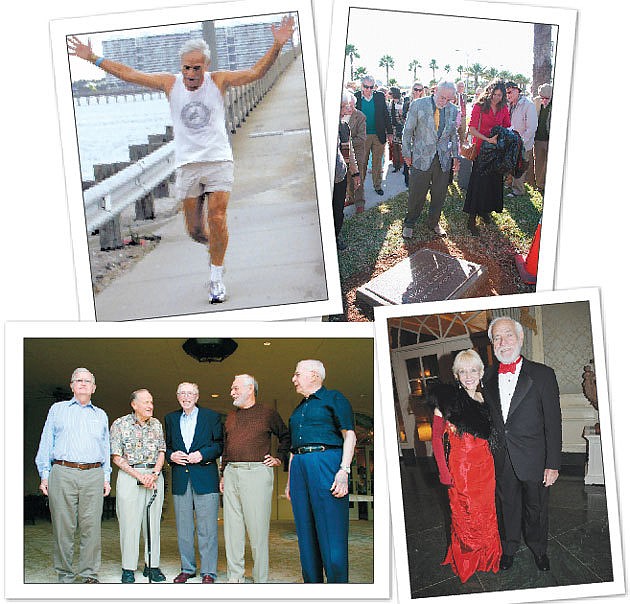- April 28, 2024
-
-
Loading

Loading

For 50 years, from 1960 to 2010, if you said the name Gil Waters in Sarasota business, civic and social circles, people knew the name and the man. He was a force. Not always liked, he could be prickly and blunt. But that didn’t matter; he was a man of action.
More recently, as he progressed through his late 80s, the inevitable occurred. The once-indefatigable Waters slowed. On Jan. 4, at age 90, Gil Waters, an incomparable visionary, died.
And with his passing, so ended the living link to remarkable and lasting contributions to Sarasota’s modern history. Of all the civic-minded people who have contributed so much to the betterment of Sarasota in the modern era, Waters stands among those at the top, if not the top.
For nearly 60 years, with a passion and forthright determination that few could, or would dare to, turn back, Waters devoted much of his life to making Sarasota better, the best it could be … for everyone.
Stop and take in all that he contributed, and we should be in awe.
That bridge? That great span that has become one of the two most distinguishing icons in Sarasota? He made it happen.
Working out of a ramshackle bungalow west of the Trail in south Sarasota, Waters strategized essentially as a committee of one, the Good Bridge Committee 2000, compiling lists of supporters, making calls to raise funds, writing letters and ad copy to marshal public support for what he saw as a “no-brainer” for the public good.
I love that photo — of Waters completing the 5K run commemorating the opening of the new fixed-span Ringling Bridge in 2003. The triumph in his arms heralded far more than finishing the run. They were exultations of Waters finishing in victory a 10-year, sometimes bitter, struggle against powerful forces, including the City Commission and business interests that opposed the fixed-span.
Five years later, in 2008, thanks to a few friends who worked behind the scenes — and no thanks to City Hall — the Legislature gave Waters his due. It renamed the Ringling Bridge the “Gil Waters Bridge on Ringling Causeway.”
Waters appreciated the recognition but said he would have preferred plaques at both ends of the bridge crediting everyone who supported the bridge and the Good Bridge Committee.
Waters left his mark on the other most distinguishing icon in Sarasota as well: the Purple Shell, the Van Wezel Performing Arts Hall.
He was one of the leaders of a 1959 committee that crafted a grand vision for Sarasota. It included constructing a performing arts hall on the bay; Bayfront Drive; Bayfront Park and the marina; turning Ringling Boulevard to four lanes; and moving City Hall to its present location.
Five years later, in 1964, the committee led a campaign for voters’ support of a bond issue to fund the improvements. The voters of Sarasota approved.
A year later, Waters continued the vision as an election platform for a seat on the City Commission. With his victory and two other commissioners, David Cohen and Sam Betz, the three brought the bond issue projects to fruition.
Their vision has stood for nearly a half-century.
Now turn out east. On the south side of University Parkway in Lakewood Ranch stands the 260,000-square-foot hurricane-fortified fortress and campus of FCCI Insurance Group Inc. In 1959, while serving as the first executive secretary of the Sarasota General Contractors Association (now the Gulf Coast Builders Exchange), Waters suggested to his board the idea of creating a self-insurance fund to reduce the cost of workers’ compensation claims for the association’s members.
The board approved, and Waters became the fund’s administrator. The idea sprouted. Soon after, the self-insurance fund became Florida Contractors and Construction Industries Self-Insurers Fund (FCCI). From that point until Waters retired as administrator in 1985, FCCI grew to $85 million in annual premiums.
Today, FCCI stands at $2.2 billion in assets; $787 million in annual premiums; operates in 18 states; and has 822 employees, 400 of them in Sarasota. All because of the entrepreneurial vision of one man 60 years ago.
“There wouldn’t be an FCCI if it weren’t for Gil Waters,” longtime FCCI board member Charles Stottlemyer told us.
Waters’ efforts to better Sarasota extended beyond business and civic affairs. Throughout the late 1990s and the first decade and a half of the 2000s, Waters and wife, Elisabeth, were fixtures of sartorial stateliness and philanthropy at the city’s galas, supporting cultural arts organizations, New College, Sarasota Memorial Hospital, Save Our Bays, Animal Rescue Coalition, among many others.
Waters believed the city’s arts could become an even greater economic engine than it already was. In the early 2000s, he attempted to bring another long-held vision to fruition — creating an international summer arts festival, involving all of the city’s arts organizations, to boost the slow summer economy. It was one of Waters’ few civic visions he was unable to birth.
Perhaps the one project Waters hoped to see most but didn’t was in that 1959 vision plan: Creating a walking European village and sky plaza — closing off from car traffic lower Main Street from Orange Avenue to Gulfstream Avenue during the day and night and constructing a walkable overpass plaza over Tamiami Trail, connecting downtown to the bay.
In 2012, at age 85, a debilitating illness taking hold, Waters and his son, Chris, tried to rally community support. It was typical Waters. Even after 60 years, he still had the will, the passion and the vision.
Just not the time.
The European plaza was an innovative vision in 1959, and remains so today. It would be a fitting tribute to perpetuate the legacy of one of Sarasota’s most historic visionaries.